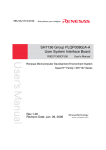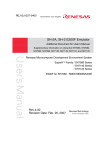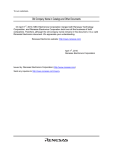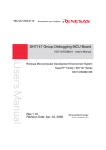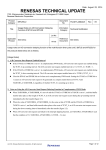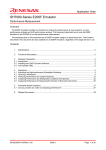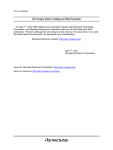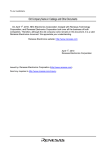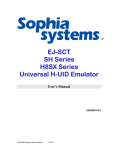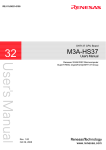Download Limitations on SuperH™ Family E10A-USB
Transcript
Rev.1.10 Limitations on SuperH™ Family E10A-USB Emulator Thank you for purchasing the SuperH™ Family E10A-USB Emulator. Note that there are limitations listed below. 1. Note on Downloading of Programs Verification cannot be enabled by selecting [Perform memory verify during download] checkbox in the [Download Module] dialog box in which download modules can be specified. To perform verification after downloading, specify verification in the [Verify Memory] dialog box opened by selecting [Verify Memory] from the [Debug] menu. 2. Note on Using E10A-USB Emulators for the SH7206 If you wish to use a PC break (software break), specify the SH2A_SBSTK command to enable use of a user stack before setting a PC break. While enabled, extra four bytes of a user stack are used when a break occurs. The value of the stack pointer (R15) must be correctly set in advance because a user stack is to be used. By default, use of a user stack is disabled. For details on the command, refer to the help file. Example To enable use of a user stack: >SH2A_SBSTK enable 3. Restriction on Use of the Emulator with the New_SH-Mobile Device Group When a break occurs while the New_SH-Mobile device group is used in user DSP mode, use of R0_BANK-R7_BANK will not be available. At this time, the values are 0. If the value of SR is changed in the [Register] window during the break in user DSP mode, this change will be reflected when the program execution resumes. Before modifying the values of R0-R7 or R0_BANK-R7_BANK, perform stepping of the program after changing the SR value so that the new mode state will be reflected. 4. Note on Connecting Two or More Emulators If two or more emulators are to be connected to a single personal computer, the emulator that was connected earlier should be in the break state whenever you connect another emulator. 5. Corrections (1) SuperH™ Family E10A-USB Emulator Additional Document for User’s Manual Supplementary Information on Using the SH7318 Please note that there is an error in 3. Low-Power States of 2.1, Differences between the SH7318 and the Emulator, in Section 2, Software Specifications when Using the SH7318: Only normal causes cancel the U standby or R standby state. Cancellation by use of the [STOP] button is not available. 1/4 (2) SuperH™ Family E10A-USB Emulator Additional Document for User’s Manual Supplementary Information on Using the SH7136 and SH7137 Although this document contains section 2.2.6, Performance Measurement Function, the SH7136 and SH7137 do not actually support the performance measurement function, including starting or ending the measurement by using Event Condition. 6. Additional Features We have added the following features to the E10A-USB Emulator V1.10 Release 00: (1) Setting the Initiator ID We have changed the way of setting the [Initiator] group box in the [Event condition 8, 9] dialog box when using the SH-4A or New_SH-Mobile device group. From the drop-down list box, select the initiator type you wish to set as the condition. (2) Additional Item for the Performance Analysis Function and Profiling Function For emulation of the SH7770, the bus master can be specified on the [System bus performance] of the performance analysis function and profiling function. 7. Note on Using the SH7243 While the SH7243 is in use, the internal trace function is not available. 8. Performance Measurement Even when [Exception/interrupt counts (EA)] is selected as the measurement item, no trap-instruction exception caused by TRAPA instructions will be counted. 9. [Select Emulator mode] Dialog Box for the SH-2A Device Group The [Select Emulator mode] dialog box opened at connection of the SH-2A E10A-USB can now be skipped. After the [Do not show this dialog box again] checkbox is selected, the [Select Emulator mode] dialog box will not be opened at the time the E10A-USB is connected. If the [Select Emulator mode] dialog box should be opened every time the E10A-USB is connected, select [Setup] -> [Emulator] -> [System...] and remove the tick from the [Do not show this dialog box again] checkbox on the [Select Emulator mode] dialog box. 10. Start/Stop Functions for the SH7080-Series Device Group The start/stop functions are useful if you wish to control the user system in synchronization with the user program execution being started or stopped. To open the [Start/Stop Function Setting] dialog box, select [Setup -> Emulator -> Start/Stop Function Setting…] or click on the [Start/Stop Function dialog box] toolbar button ( ). Figure [Start/Stop Function Setting] Dialog Box 2/4 The [Start/Stop Function Setting] dialog box contains the following options. [Run the specified routine just before the user program execution is started.] checkbox: Select this box if you wish to run a user routine just before the user program execution is started. [Start address]: Specify an address where a routine will start to run just before the user program execution is started. You can also specify a label. [Run the specified routine just after the user program execution is stopped.] checkbox: Select this box if you wish to run a user routine just after the user program execution is stopped. [Start address]: Specify an address where a routine will start to run just after the user program execution is stopped. You can also specify a label. For details, refer to the START_FUNCTION_BEFORE and STOP_FUNCTION_AFTER command pages in the help information for the SH7080-series E10A-USB. There are also the following notes. • An RTS instruction must be written at the end of the user routine. • The user routine must end. • No break should occur within the user routine. • No interrupt should be accepted in the user routine. • The user routine to run before the user program execution is started must end within 2 ms. • The user routine to run after the user program execution is stopped must end within 30 s. • User stack should be used by the user routine to run after user program execution. • If the user routine is to use a general-purpose register, saving the contents of the register, making the initial setting, and restoring the contents should all be done within the routine. • If values are set via the [Registers] window of the HEW just before user program execution is started, these values will not be reflected to the user routine. • If values of general-purpose registers are changed by the user routine, execution of the user program being debugged will not be affected. • While profiling is in progress, the user routine (start or stop) runs whenever branch information is acquired. 11. Note on Using the SH7263 When you use the DMAC in the SH7263, do not select the non-realtime trace mode as the AUD trace acquisition mode. 12. MCU Operating Modes Boot mode, user boot mode, and user programming mode are not supported in the systems listed below. For this reason, the on-chip flash memory cannot be programmed while the user program is running. • SH7080 Series E10A-USB SYSTEM (CPU SH-2) • SH7125 Series E10A-USB SYSTEM (CPU SH-2) • SH7125 Series Debug MCU BOARD E10A-USB SYSTEM (CPU SH-2) • SH7147 Series Debug MCU BOARD E10A-USB SYSTEM (CPU SH-2) • SH7137 Series E10A-USB SYSTEM (CPU SH-2) • SH-2A FLASH E10A-USB SYSTEM 13. Event Condition for the SH-2A, SH7080-Series Device Group (1) When matching of the program counter value is a condition of Event Condition for internal trace acquisition (i.e. [Only program fetched address] or [Only program fetched address after] is selected), do not specify addresses in the on-chip ROM or on-chip RAM as the address condition. (2) If you specify a break (by selecting the [Acquire Break] checkbox) and trace acquisition (by selecting [Condition] from the [Acquire Trace] list box) on the [Action] page as the action to take when a condition of Event Condition is satisfied, setting of the trace acquisition will be ignored. 3/4 14. Break Cause Under the following conditions, the emulator shows the cause of last break when the internal trace buffer becomes full. • A break of the user program has been specified as the action to take when the internal trace buffer becomes full. • The user program has started to run from the address where a condition of Event Condition had been set. 4/4




